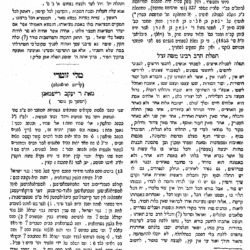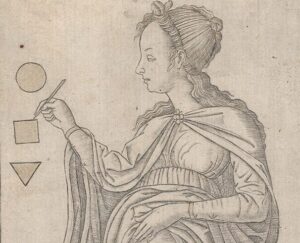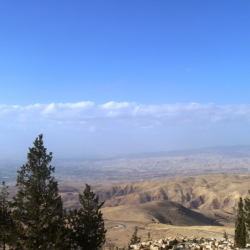| Source (Hebrew) | Translation (English) |
|---|---|
תפלת הרב רבינו משה זצ״ל |
The prayer of our teacher Rabbi Mosheh, zts”l[1] i.e., Rabbi Mosheh ben Maimon (RaMBaM), Maimonides (1138-1204) |
תְּפִלָּה לִסְגֻלַּת אִשִּׁים, לְמִבְחַר אֲנָשִׁים, לְחַכְמֵי חֲרָשִׁים, לִנְבוֹנֵי לְחָשִׁים, לְחוֹפְשֵׂי טְמוּנִים, לִמְפַעְנְחֵי צְפוּנִים, לְדוֹרְשֵׁי יֵשׁ אֵין לְפָנָיו אַיִן, אֲשֶׁר לֹא תְּשׁוּרֶנּוּ עַיִן, וְהַבּוֹרֵא הַכֹּל יְסוֹד הַיְּסוֹדוֹת, וְסוֹד הַסּוֹדוֹת, שְׁמוֹ עַצְמוֹ וְעַצְמוֹ שְׁמוֹ, אֲשַׁבֵּחַ וְאַהַלֵּל לִשְׁמוֹ, אעפ״י כִּי הַשְּׁתִיקָה הִיא שִׁבְחוֹ וּתְהִלָּתוֹ דּוּמִיָּה, גְּדֹל הָעֵצָה וְרַב הָעֲלִילִיָּה, לְכָל יְצוּרָיו כֻּלָּם, הוּא יְיָ׳ אֱלֹהִים אֱמֶת הוּא אֱלֹהִים חַיִּים וּמֶלֶךְ עוֹלָם. (ירמיהו י:י) |
A prayer for distinguished individuals, for the choicest of people, for the sages of craft, for the wise in whispers, for seekers of the hidden, for decoders of the concealed, for seekers of [the] Being-before-whom-there-was-nothing, whom no eye can behold, and the Creator of all, the Foundation of foundations, the Secret of secrets— Their Name is Their essence, and Their essence is Their Name— I praise and extol Their Name, even though silence is Their praise, and quietude Their glory. great in counsel and mighty in deed, toward all Their creatures, every one, They are YHVH, the true deity (elohim emet), They are the living deity (elohim ḥayyim) and eternal king. (Jeremiah 10:10) |
יִשְׁתַּבַּח אֱלוֹהַּ אֶחָד וְלֹא כְּאֶחָד מִן הָאֲחָדִים, יָחִיד וּמְיֻחָד לֹא כִּיחִידִים, אֶחָד מֵאֵין תְּחִלָּה וְתִכְלָה, אֶחָד מֵאֵין רֵאשִׁית וְאַחֲרִית, אֶחָד וְאֵין שֵׁנִי וְלֹא כְּאֶחָד הַמְּנוּיִין, אֶחָד מֵאֵין חִבּוּר וְאוֹסֵף, אֶחָד מֵאֵין פֵּרוּד וְחִלּוּק, מְקוֹר כָּל מָצאוּי לַעֲדֵי עַד, תְּהִלָּתוֹ בְּלֹא תַּכְלִית, הַמֻּבְדָּל מִגּוּף, וּמֵיִצְרֵי הַגּוּף מִצֶּלֶם וּמִדְּמוּת וּמִתְּמוּנָה, מִכַּמּוּת וּמֵאֵיכוּת וּמִסְּמִיכוּת וּמְאָנָה וּמִמָתַי וּמִקִּנְיָן וּמִן מַתְכֹּנֶת תַּבְנִית מִהְיוֹת יַעֲשֶׂה וּמִהְיוֹת יַעֲשֶׂה, וְהַכֹּל נִבְרְאוּ בּוֹ בְּלִי עֲשׂוֹת כִּי כָּל אֲשֶׁר נִבְרָא אֶחָד בִּלְתּוֹ לֹא בֶּאֱמֶת הוּא אֶחָד, וְלֹא בְּאֱמוּנָה הוּא מְיֻחָד, כִּי מְחֻבָּר מֵאֲחֵדִים וּבָנוּי הוּא מִנִּפִרָדִים, גַּם נִפְרָד לַאֲחָדִים, וְנֶחֱלָק לַנִּפְרָדִים, גַּם לוֹ יֵשׁ תְּחִלָּה וְסוֹף וְקֵץ וְתַכְלִית וְרֵאשִׁית וְאַחֲרִית אָחוֹר וְקָדַם עֵרֶךְ וְדִמְיוֹן, גַּם יֵשׁ לוֹ שֵׁנִי לְגָדְרוֹ וְדוֹמֶה לוֹ לְצִדּוֹ, וְכָמוֹהוּ יֵשׁ עוֹד, אֲבָל בּוֹרֵא הַכֹּל יִתְבָּרַךְ וְיִתְעַלֶּה אֵין עוֹד מִלְּבַדּוֹ. |
Elo’ah be praised— One, but not like any other one among ones, singular and unique, not like other singularities, One without beginning or ending, One without genesis nor eschaton, One without a second, and not like a countable one, One without combination or addition, One without separation or division, the source of all that comes forth, forever and ever, Their praise is without end, They are separate from body, and from bodily passions from image, likeness, and form, from quantity, quality, and adjacency, from where and when[2] space and time and acquisition, and from structural form, from being formed or forming action, yet all things were created through Them without [actual] action, for anything created that is “one” apart from Them is not truly one, and is not truly one in the way of Their oneness, for it is composed of individual parts, and it is built from separate components, it is also separable into units, and divisible into parts, it also has a beginning and an end, a limit and a purpose, a first and a last, a back and a front, proportion and resemblance, it even has a second to define its boundary, and something similar to it at its side, and still others like it exist. but the Creator of all, may They be blessed and exalted, there is none besides Them. |
יָהּ הַכֹּל תָּלוּי בּוֹ, וּמִמֶּנּוּ וְאֵלָיו הַכֹּל, וּבוֹ וְעִמּוֹ הַכֹּל, וַאֲמִתָּתָם בַּאֲמִתָּתוֹ קַיֶּמֶת. |
Yah! All depends on Them, from Them and to Them is all, in Them and with Them is all, and the reality (of Creation) endures only through Their reality. |
אֱלוֹהַּ יָפֻצוּ מַעְיָנוֹת אוֹרוֹ לִבְרוּאָיו שֶׁאֵין כָּלוֹת תָּמִיד, בְּלִי לִיאוּת, וְנֶהֱנִים מִזִּיו זֹהַר מְקוֹרוֹ רוּחוֹת וּנְשָׁמוֹת וּשְׂכָלִים נִפְרָדִים, מַלְאָכִים וְגַלְגַּלִּים, וְאֲרִאֵל וסרוגל וְהַגַלְגַל הָרַב מֵרַב תַּאֲוָתוֹ, וְעֹצֶם אַהֲבָתוֹ לְחֵשֶׁק בּוֹרֵא הַכֹּל, נֶחְפָּז לָלֶכֶת סָבִיב לַעֲרָבוֹת בְּהִירוּת בְּרַק נָגְהוֹ, וּשְׁאָר הַגַּלְגַּלִּים יִסַּבּוּ בְּלֶכְתָּם אֲחוֹרַנִּית נֶחְפָּזִים לָלֶכֶת בְּלִי הֶפְסֵק כְּמִתְלַהְלֵהַּ, לֹא יוּכְלוּ לְהִתְמַהְמֵהַּ, וְהָאוֹר הוֹלֵךְ וְאוֹר עַד אֵין קֵץ, לַמְּנַצֵּחַ שִׁיר מִזְמוֹר, (תהלים סו:א) לַחְשֹׁב בַּשֵּׂכֶל וְלֵאמֹר תְּהִלָּתוֹ בְּלִי אֹמֶר, וְלוֹ דּוּמִיָּה תְּהִלָּה, וּמִי יֹאמַר וּמַה יֹאמַר גּוּף וְגוּף, כָּל אוֹמֵר יִקְטַן לְהַגִּיד מִקְצָת פְּעֻלּוֹתָיו, וְאֵין קָצֶה לְנִפְלְאוֹתָיו, וְכָל עַיִן לֹא יַסְפִּיק לִרְאוֹת וְכָל פֶּה יִרְפֶּה, וְכָל שָׂפָה רָפָה, לְהַגִּיד וּלְדַבֵּר עֹצֶם טֶבַע מְצִיאוּתוֹ וְכָל עַפְעַף יִיעַף, וְכָל יְצוּר יִיגָע, וְלֹא יִגַּע אֶל יְדִיעַת אֲמִתַּת יְצִירוֹתָם, כִּי אֵין לַדָּבָר סוֹף וְלָעֹמֶק מַחְשְׁבוֹתָיו הַדֵּעוֹת נְבוֹכוֹת וְהָרוּחוֹת נִבְהָלוֹת, וְהַנְּפָשׁוֹת צוֹפִיּוֹת וְהַנְּפָשׁוֹת הֹמִיּוֹת, וְהַשְּׂכָלִים מִשְׁתַּלְשְׁלִים, וְהַמַּלְאָכִים וְהַפְּלָכִים, רָצִים וְאַצִּים, סוֹבְבִים נְבֻכִים, בְּאַהֲבַת בּוֹרֵא הַכֹּל, שֵׂכֶל הַכֹּל וְנֶפֶשׁ הַכֹּל וּמְרוֹמַם עַל כָּל בְּרָכָה וּתְהִלָּה יָת׳ וְיָת׳ לָעַד וּלְנֵצַח נְצָחִים א׳ נ׳ ס׳. |
Elo’ah — may the fountains of Their light stream forth to Their creatures who never cease, without weariness, and who delight in the radiance of Their luminous source— spirits and souls and separate intelligences, angels and celestial spheres, and ARIEL[3] the Heavenly Temple; Cf. Isaiah 29:1. Also find, Mishneh Torah, Foundations of the Torah 2:7 and SRUGL[4] Compare with סרגול ≈ scribal ruler for scoring lines on a parchment. Possibly, a conceptualization of a divine stylus or straightedge (as used in Geometry). and the Primum Mobile[5] the Outermost Sphere. “In classical, medieval, and Renaissance astronomy, the Primum Mobile (Latin: “first movable”) was the outermost moving sphere in the geocentric model of the universe. The concept was introduced by Ptolemy to account for the apparent daily motion of the heavens around the Earth, producing the east-to-west rising and setting of the sun and stars, and reached Western Europe via Avicenna.” (Wikipedia) — from the abundance of its craving, and the object of its love in desiring the Creator of all— hastens to encircle the Aravot[6] The 7th heaven or realm of the uppermost sphere; find Rambam, Guide for the Perplexed, Part 1:70 the brightness of Their shining radiance. And the other spheres revolve in their motion, hastening backward in their course without pause, like one endlessly circling. They cannot tarry, and the light goes on and shines endlessly. “To the conductor, a song of praise!” (Psalms 66:1) To reflect with the intellect, and to declare Their praise without speech. And silence is praise to Them. And who can say and what can any body say? All who speak fall short even to tell a fraction of Their works, and there is no limit to Their wonders. Every eye cannot suffice to see, and every mouth fails, and every tongue falters to articulate and speak the core of Their essential nature. Every eyelid grows weary, and every creature grows tired, yet will not attain knowledge of the truth of their creation, for the matter has no end. And in the depth of Their thoughts, understandings become confused, and spirits are shaken, souls observe, and souls are overwhelmed, and intellects descend in succession. Angels and Pelakhim,[7] An alternative name for galgalim — spheres. Rambam distinguishes angels from spheres, angels are abstract whereas spheres are physical; find Mishneh Torah, Yesode haTorah 2-3 run swiftly, turn in confusion, in love for the Creator of all. The intellect of all, and the soul of all, exalted above all blessing and praise— may He be blessed and exalted forever, and for the eternity of eternities— Amen Netsaḥ Selah. |
אָנָּא עִלַּת הָעִלּוֹת וְסִבַּת הַסִּבּוֹת, הַקַּדְמוֹן לְכָל קַדְמוֹן, רִאשׁוֹן לְכָל רִאשׁוֹן, עֶזְרָה בְצָרוֹת נִמְצָא מְאֹד, הַמַּמְצִיא הַכֹּל בִּרְצוֹנוֹ, הַמְּקַיֵּם הַמְּצִיאוּת כֻּלּוֹ בֶּאֱמֶת מְצִיאוּתוֹ, הַנִּמְצָא הָאֲמִתִּי אֲפִי׳ אִם יֵעָדֵר הַמְּצִיאוּת הַמָּצוּי זוּלָתוֹ, אֶהְיֶה אֲשֶׁר אֶהְיֶה (שמות ג:יד) לֹא סָר לִהְיוֹת נִשְׁאָל בְּלִי שׁוֹאֵל, בְּךָ תְּחַזֵּק הַתִּקְוָה וְהַמַּחֲשָׁבוֹת סוֹדְךָ יִכְלֶה הַקֵּץ שִׂימָה נָּא עָרְבֵנִי עִמָּךְ וְאֶהְיֶה לְפָנֶיךָ מְקֻבָּל כִּי הִשְׁתַּדַּלְתִּי בַּמֶּה שֶׁלֹּא הִשַּׂגְתִּי, אֶלָּא אִם תּוֹשִׁיעֵנִי וְסַעֲדֵנִי וְאִוָּשֵׁעָה וְאֶשְׁעָה בְחֻקֶּיךָ תָמִיד. (תהלים קיט:קיז) בָּרוּךְ אַתָּה ה׳ שׁוֹמֵעַ תְּפִלָּה אָמֵן סְלִיק׃ |
Please— Cause of causes, and Prime Source of all causes, the First of all that is first, the Beginning of all beginnings, a ready help in distress, abundantly present, who brings all into existence by Their will, who sustains all being by the truth of Their being, the truly existing One— even if the existence of all else were absent, They remain. Ehyeh-Asher-Ehyeh[8] In the translation of Everett Fox: “I will be-there howsoever I will be-there” (Exodus 3:14)— never ceases to inquire with those who do not ask[9] Cf. Isaiah 65:1 In you hope finds strength, and thoughts your counsel.[10] Cf. Proverbs 15:22 May the end(lessness of metaphysical inquiry[11] Cf. Psalms 119:96. – Nir ) arrive. Please, vouchsafe me to you,[12] Cf. Psalms 119:122 and may I be accepted before you, for I strove, even if I could not achieve anything. Only if you save me and sustain me— then I shall be saved, and I shall contemplate your statutes continually. (Psalms 119:117) Blessed are you, Hashem, who hears prayer. Amen. Seliq |
This prayer for divine contemplatives, beginning with the incipit “Tefilat Lisgulat Ishim” (prayer for distinguished individuals), is attested in several manuscripts prefaced by the title, תפלת הרב רבינו משה זצ״ל (prayer of our teacher, Rabbi Mosheh, may their righteousness be remembered for a blessing). The Rabbi Mosheh here refers to Rabbi Mosheh ben Maimon — Maimonides (1138-1204). While surprising to some past scholars, our reading of the prayer finds nothing outside the concepts articulated by Rambam in his Mishneh Torah (Yesodei haTorah) and Moreh Nevukhim. It is certainly not a modern, or even an early modern forgery. This transcription, vocalization, and transcription was made from fol. 150a in Warner 41 (Leiden Or. 4779). Moritz Steinschneider (1815-1907), in his Catalogus codicum hebraeorum Bibliothecae academiae Lugduno Batavae ([Leiden]: E. J. Brill. 1858). p. 188, describes the manuscript and folio as follows:
Source (Latin) Translation (English)
Ultimately, Steinschneider’s transcription of the prayer was published in the column, “Ha-Sharon: Devarim Atiqim” in Ha-Karmel (no. 44, 12 July 1867, cumulative page 350). There he introduces the text, “התפלה הזאת נעתקה לי מכ״י הנמצא באוקספורד, ושכחתי לציין ציונו ומספרו, ואין ספק שהיא היא התפלה המיוחסת לרמב״ם בכ״י פאריז מספר 837 (לפי הרשימה החדשה) המתחלת ג״כ תפלה לסגולת אישים.” (This prayer was transcribed for me from a manuscript located in Oxford, but I forgot to record its catalog mark and number. There is no doubt, however, that it is the same prayer attributed to the Rambam [=Rabbi Moses ben Maimon] found in the Paris manuscript no. 837 (according to the new catalog), which likewise begins: “A Prayer for Distinguished Individuals.”). While the location of this Oxford manuscript remains unknown, Steinschneider’s transcription is very close to our own with only a few missing words. (The scholar Eliakim Carmoly provided the reference to a third manuscript in his 1842 work עקטאן, which we have requested from the Bliblitheque Nationale de Paris for purposes of comparison.)
The historian of Jewish medicine, Fred Rosner (1935-2024), follows Alexander Suessmann Muntner (1897-1973) in dismissing this prayer as a forgery. Rosner considered the “astrological” imagery and style antithetical to Maimonides.[13] Rosner’s opinion on this prayer appears in a digression made in his 1967 article “The Physicians Prayer attributed to Moses Maimonides“, that largely focuses on yet another prayer attributed to Maimonides that first appears in German in 1783, and is later attributed to the student of Immanuel Kant and doctor to Moses Mendelssohn, Dr. Markus Herz. What may have also given pause to scholars was the admission by Steinschneider that he had forgotten the shelf mark to the mansucript from which his transcription purportedly derives. The second manuscript Steinschneider mentioned in his published transcription, Paris Ms. Hébreu 873, had been handled by Eliakim Carmoly (1802-1875) — a scholar whose reputation had been sullied by accusations of forgery. Meanwhile, it is unclear to me whether anyone concerned with the authenticity of the prayer text checked Warner 41, fol. 150.
It is almost too easy to forget the pleasant and beneficial conditions under which we operate today when so many page images are available online. Not only are we grateful to the archivists and librarians at the University of Leiden who made this resource accessible, but to the entire vision and funding apparatus in the Netherlands and the European Union seeking to preserve and make publicly accessible such treasures. Steinschneider’s transcription from that 1867 issue of Ha-Karmel was accessed via the National Library of Israel’s historical newspaper database and we are grateful to all those who work to maintain and grow that database. Translations of my Latin transcriptions from Steinschneider’s catalogues were aided by Google Translate and ChatGPT (OpenAI).
For this work published here at the Open Siddur, we are grateful to Simcha Daniel Burstyn and Nir Krakauer for correcting my transcription, and for proposing the current vocalization. My transcription used Steinschneider’s transcription as a base text. Nir was able to correct this transcription after I located Warner 41 and fol. 150 in the collection of the University of Leiden. Nir also offered compelling annotation including relevant citations to Maimonides’ Mishneh Torah and Moreh Nevukhim. As far as I know, this is the first time this work has been translated in any language.
While we wait for the librarians in the special collection of the Bibiliotheque Nationale de Paris to respond to our request, we are pleased to help reveal and hopefully uncomplicate the history of this prayer attributed to Maimonides. We welcome scholars with an expertise in the era during and after the life of Maimonides to comment on the content of the prayer and its parts and whether they may have been composed within the circle of his students dedicated to contemplative Jewish practice.
Source(s)
Notes
| 1 | i.e., Rabbi Mosheh ben Maimon (RaMBaM), Maimonides (1138-1204) |
|---|---|
| 2 | space and time |
| 3 | the Heavenly Temple; Cf. Isaiah 29:1. Also find, Mishneh Torah, Foundations of the Torah 2:7 |
| 4 | Compare with סרגול ≈ scribal ruler for scoring lines on a parchment. Possibly, a conceptualization of a divine stylus or straightedge (as used in Geometry). |
| 5 | the Outermost Sphere. “In classical, medieval, and Renaissance astronomy, the Primum Mobile (Latin: “first movable”) was the outermost moving sphere in the geocentric model of the universe. The concept was introduced by Ptolemy to account for the apparent daily motion of the heavens around the Earth, producing the east-to-west rising and setting of the sun and stars, and reached Western Europe via Avicenna.” (Wikipedia) |
| 6 | The 7th heaven or realm of the uppermost sphere; find Rambam, Guide for the Perplexed, Part 1:70 |
| 7 | An alternative name for galgalim — spheres. Rambam distinguishes angels from spheres, angels are abstract whereas spheres are physical; find Mishneh Torah, Yesode haTorah 2-3 |
| 8 | In the translation of Everett Fox: “I will be-there howsoever I will be-there” |
| 9 | Cf. Isaiah 65:1 |
| 10 | Cf. Proverbs 15:22 |
| 11 | Cf. Psalms 119:96. – Nir |
| 12 | Cf. Psalms 119:122 |
| 13 | Rosner’s opinion on this prayer appears in a digression made in his 1967 article “The Physicians Prayer attributed to Moses Maimonides“, that largely focuses on yet another prayer attributed to Maimonides that first appears in German in 1783, and is later attributed to the student of Immanuel Kant and doctor to Moses Mendelssohn, Dr. Markus Herz. |

“תְּפִלָּה לִסְגֻלַּת אִשִּׁים | Prayer for a practice of divine contemplation, attributed to Rabbi Mosheh ben Maimon (as found in Leiden Or. 4779, et al)” is shared through the Open Siddur Project with a Creative Commons Attribution-ShareAlike 4.0 International copyleft license.









Leave a Reply